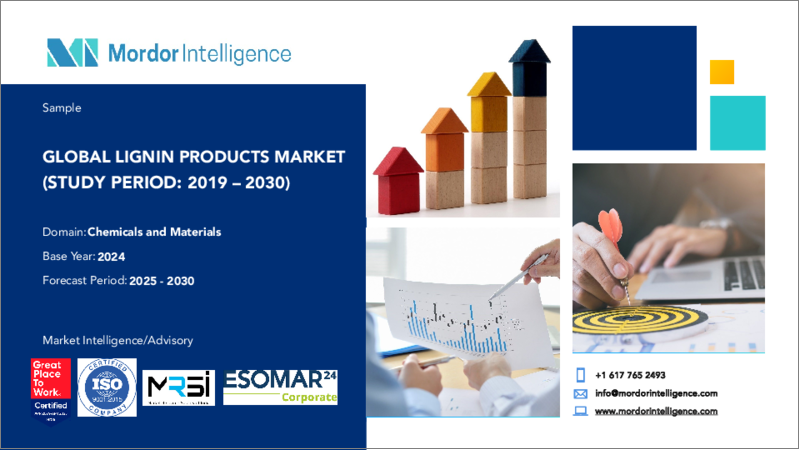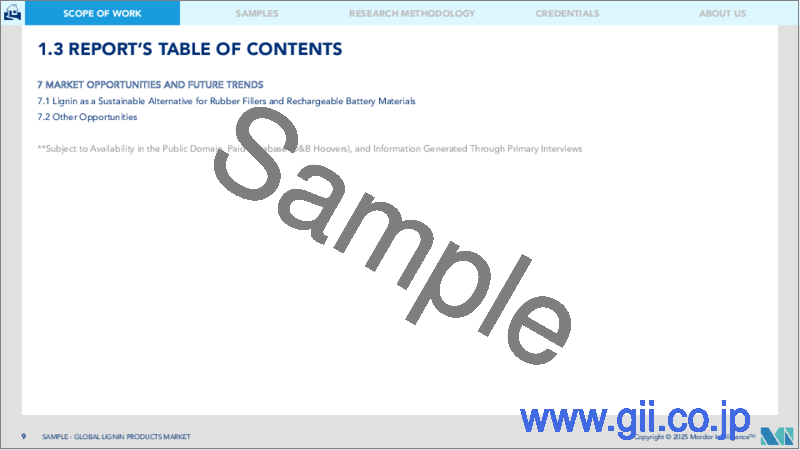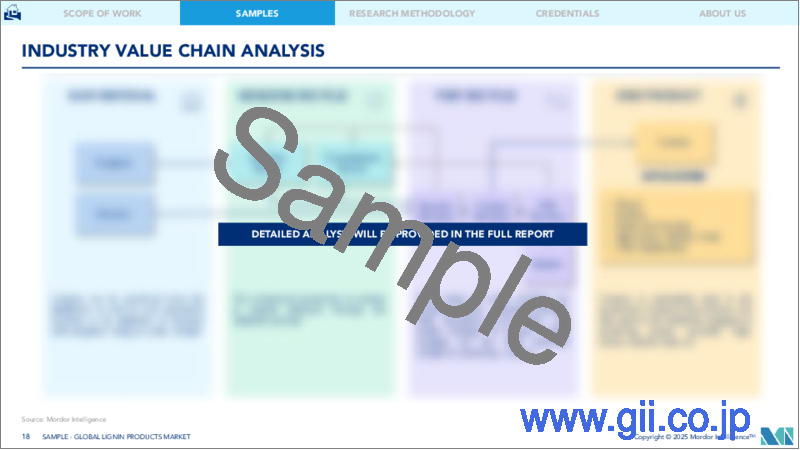|
|
市場調査レポート
商品コード
1640418
リグニン製品-市場シェア分析、産業動向・統計、成長予測(2025年~2030年)Lignin Products - Market Share Analysis, Industry Trends & Statistics, Growth Forecasts (2025 - 2030) |
||||||
カスタマイズ可能
適宜更新あり
|
|||||||
| リグニン製品-市場シェア分析、産業動向・統計、成長予測(2025年~2030年) |
|
出版日: 2025年01月05日
発行: Mordor Intelligence
ページ情報: 英文 120 Pages
納期: 2~3営業日
|
全表示
- 概要
- 目次
リグニン製品市場は予測期間中に3.5%以上のCAGRで推移する見込み。

COVID-19パンデミックは市場にマイナスの影響を与えました。これは、封鎖や制限により製造施設や工場が閉鎖されたためです。サプライチェーンと輸送の混乱はさらに市場に障害をもたらしました。しかし、2021年には産業は回復し、市場の需要は回復しました。
主要ハイライト
- 短期的には、コンクリート混和剤におけるリグノスルホン酸塩の消費増加と動物飼料需要の増加が市場を牽引すると予想されます。
- その反面、研究開発活動と消費者製品との間に存在するギャップが、調査対象市場の成長を阻害する可能性が高いです。
- しかし、化石由来の原料を代替することの人気の高まりは、予測期間中に数多くの機会を提供すると予想されます。
- 消費量では欧州が市場を独占しているが、予測期間中のCAGRはアジア太平洋が最も高くなると予想されます。
リグニン製品市場の動向
コンクリート添加剤が市場を独占する見込み
- リグニンとその製品は、バインダーや粉塵抑制剤などのコンクリート添加剤として使用されます。リグニンはグラスウール断熱材のバインダーとして使用されます。アスファルトバインダーの性能を向上させています。
- スルホン酸リグニンは歴史的に、路面の安定化と防塵のために道路で使用されてきました。リグニンベースの製品は、一般的に路面に塗布される石油や塩ベースの製品よりも安全で経済的です。例えば、米国国勢調査局によると、2022年の米国における高速道路と道路プロジェクトへの建設支出額は1,098億1,000万米ドルで、2021年と比較して9%の増加を示しました。したがって、道路建設への投資の増加は、予測期間中にリグニンベースの製品に対する需要を生み出すと予想されます。
- 地域的には、コンクリート添加剤としてのリグニン消費は欧州がリードしています。しかし、アジア太平洋は予測期間中に最も速いCAGRで推移すると予想されます。
- アジア太平洋で進行中の大規模なインフラプロジェクトが、この地域の市場を押し上げると予想されています。例えば、India Brand Equity Foundation(IBEF)によると、2022~2023年度連邦予算において、インド政府はインド国道庁(NHAI)に172億4,000万米ドルを割り当てました。このため、国内ではリグニンベースの製品の需要が見込まれます。
- 土木学会(ICE)の調査によると、世界の建設産業は2030年までに8兆米ドルに達すると予想されており、その主要牽引役は中国、インド、米国です。
- 建設産業の成長により、コンクリート添加剤を含む様々な建設用化学製品の需要が増加すると予想され、これが最終的にリグニンベースの製品市場を牽引することになります。
欧州が市場を独占する展望
- ドイツや英国といった国々が存在するため、予測期間中は欧州が市場を独占すると予想されます。
- 欧州連合(EU)は、様々な悪影響があるとして、様々なセグメントでの化学品の使用に厳しい規制を課しています。肥料、その他の農業用化学品、水処理用化学品が主要懸念事項です。
- こうした結果を回避するため、この地域ではバイオベース製品の需要が高まっており、これがドイツにおけるリグニン製品の需要を促進すると予想されています。
- 例えば、ドイツでは新しい建築物の20%以上が、リグニンから作られたコンクリート混和剤などの天然材料を使用しています。
- さらに、2030年FTIP(連邦交通インフラ計画)のもと、連邦政府は2016~2030年までにドイツの道路に1,476億米ドルを投資すると発表しました。このうち744億米ドルは、構造物のメンテナンスとインフラ交換に充てられます。
- 航空宇宙産業と自動車産業の主要拠点であるドイツでは、これらのセグメントからの炭素繊維需要が増加しています。例えばイタリアでは、2021年の自動車生産台数が79万5,856台となり、2020年比で2%増加しました。これはリグニン需要を促進すると予想されます。リグニンは、性能を損なうことなく低コストの炭素繊維の生産に使用されます。
- また、英国では、より良いインフラを国民に提供するため、政府は国家生産性投資基金(NPIF)の一環として、2020~2050年にかけてGDPの1~2%をインフラに投資することを計画しています。さらに、英国は濃厚飼料、飼料サプリメント、混合飼料の主要生産国でもあります。例えば、Office for National Statistics(英国国家統計局)によると、メーカーの2021年の家畜飼料の販売額は51億4,000万英ポンド(70億7,000万米ドル)で、2020年と比較して15.8%の増加を示しています。
- 以上の要因から、予測期間中、欧州が世界市場を独占すると予想されます。
リグニン製品産業概要
リグニン製品市場は統合型です。この市場の主要企業には、Borregaard AS、Domsjo Fabriker、Sappi、Burgo Group SpA、Nippon Paper Industriesなどが含まれます(順不同)。
その他の特典
- エクセル形式の市場予測(ME)シート
- 3ヶ月間のアナリストサポート
目次
第1章 イントロダクション
- 調査の前提条件
- 調査範囲
第2章 調査手法
第3章 エグゼクティブサマリー
第4章 市場力学
- 促進要因
- 高品質コンクリート混和剤へのニーズの高まり
- 飼料需要の増加
- 分散剤におけるリグニンの使用増加
- 抑制要因
- 研究開発と消費者製品のギャップ
- 産業バリューチェーン分析
- ポーターのファイブフォース分析
- 供給企業の交渉力
- 消費者の交渉力
- 新規参入業者の脅威
- 代替品の脅威
- 競合の程度
第5章 市場セグメンテーション
- 出所
- セルロース系エタノール
- クラフトパルプ
- 亜硫酸パルプ
- 製品タイプ
- リグノスルホン酸塩
- クラフトリグニン
- 高純度リグニン
- 用途
- コンクリート添加剤
- 飼料
- バニリン
- 分散剤
- 樹脂
- 活性炭
- 炭素繊維
- プラスチック/ポリマー
- フェノールと誘導体
- その他の用途(ブレンド、吸着剤など)
- 地域
- アジア太平洋
- 中国
- インド
- 日本
- 韓国
- その他のアジア太平洋
- 北米
- 米国
- カナダ
- その他の北米地域
- 欧州
- ドイツ
- 英国
- フランス
- 北欧諸国
- その他の欧州
- その他
- ブラジル
- サウジアラビア
- その他の国
- アジア太平洋
第6章 競合情勢
- M&A、合弁事業、提携、協定
- 市場シェア分析**/ランキング分析
- 主要企業の戦略
- 企業プロファイル
- Borregaard AS
- Burgo Group SpA
- Domsjo Fabriker
- GREEN AGROCHEM
- Ingevity Corporation
- NIPPON PAPER INDUSTRIES CO., LTD.
- Rayonier Advanced Materials
- SAPPI
- Stora Enso
- The Dallas Group of America
- UPM
- WUHAN EAST CHINA CHEMICAL CO.,LTD
第7章 市場機会と今後の動向
- 化石由来原料の代替の人気の高まり
The Lignin Products Market is expected to register a CAGR of greater than 3.5% during the forecast period.

The COVID-19 pandemic negatively impacted the market. This was because of the shutdown of the manufacturing facilities and plants due to the lockdown and restrictions. Supply chain and transportation disruptions further created hindrances for the market. However, the industry witnessed a recovery in 2021, thus rebounding the demand for the market studied.
Key Highlights
- Over the short term, increased consumption of lignosulfonates in concrete admixtures and the rising demand for animal feed are expected to drive the market.
- On the flip side, the existing gap between R&D activities and consumer products is likely to hinder the growth of the market studied.
- However, the increasing popularity of substituting fossil-based raw materials is anticipated to provide numerous opportunities over the forecast period.
- Europe dominated the market in terms of consumption, however, Asia-Pacific is expected to have the highest CAGR during the forecast period.
Lignin Products Market Trends
Concrete Additives are Expected to Dominate the Market
- Lignin and its products use concrete additives such as binders and dust suppressants. They are used as binders for glass wool building insulation. They improve the performance of asphalt binders.
- Lignin sulphonate has been historically used on roads for surface stabilization and dust control. Lignin-based products are safer and more economical than petroleum- and salt-based products typically applied to road surfaces. For instance, according to the US Census Bureau, in 2022, the value of construction spending on highway and street projects in the United States amounted to USD 109.81 billion, which showed an increase of 9% compared with 2021. Therefore, increasing investments in road construction are expected to create demand for lignin-based products over the forecast period.
- Geographically, Europe leads the way in consuming lignin as a concrete additive. However, Asia-Pacific is expected to register the fastest CAGR over the forecast period.
- The significant infrastructure projects underway in Asia-Pacific are expected to boost the regional market. For instance, according to the India Brand Equity Foundation (IBEF), In the Union Budget 2022-2023, the Indian government allocated USD 17.24 billion to the National Highways Authority of India (NHAI). Therefore, this is expected to create demand for lignin-based products in the country.
- According to a study by the Institution of Civil Engineers (ICE), the global construction industry is expected to reach USD 8 trillion by 2030, primarily driven by China, India, and the United States.
- The growing construction industry is expected to increase the demand for various construction chemicals, including concrete additives, which will eventually drive the market for lignin-based products.
Europe is Expected to Dominate the Market
- The European region is expected to dominate the market during the forecast period due to the presence of countries like Germany and the United Kingdom.
- The European Union imposed stringent regulations on the use of chemicals in various segments due to various adverse effects. Fertilizers, other agricultural chemicals, and water treatment chemicals are major concerns.
- To avoid these consequences, the demand for bio-based products has increased in the region, which, in turn, is expected to propel the demand for lignin products in Germany.
- For instance, more than 20% of the new constructions in Germany use natural materials, such as concrete admixtures made from lignin.
- Moreover, under the 2030 FTIP (Federal Transport Infrastructure Plan), the federal government announced it will invest USD 147.6 billion in Germany's roads from 2016 to 2030. USD 74.4 billion will be allocated for structural maintenance and replacement infrastructure.
- Being the major hub for aerospace and automotive industries, Germany witnessed an increased demand for carbon fibers from these segments. For instance, In Italy, automotive production in 2021 amounted to 795,856 units, showing an increase of 2% compared with 2020. This is expected to drive the demand for lignin. Lignin is used in the production of low-cost carbon fibers without compromising performance.
- Additionally, in the United Kingdom, to provide better infrastructure to the population across the country, the government has planned to invest 1-2% of the GDP in infrastructure between 2020 and 2050 as part of the National Productivity Investment Fund (NPIF). In addition, the United Kingdom is a major producer of concentrated animal feed, feed supplements, and unmixed feeds. For instance, according to Office for National Statistics (UK), manufacturers' sales of farm animal feed had a value of 5.14 billion British pounds (USD 7.07 billion) in 2021, which showed an increase of 15.8% compared with 2020.
- Based on the factors above, Europe is expected to dominate the global market during the forecast period.
Lignin Products Industry Overview
The Lignin Products Market is consolidated in nature. The major players in this market include (not in a particular order) Borregaard AS, Domsjo Fabriker, Sappi, Burgo Group SpA, and Nippon Paper Industries Co. Ltd., among others.
Additional Benefits:
- The market estimate (ME) sheet in Excel format
- 3 months of analyst support
TABLE OF CONTENTS
1 INTRODUCTION
- 1.1 Study Assumptions
- 1.2 Scope of the Study
2 RESEARCH METHODOLOGY
3 EXECUTIVE SUMMARY
4 MARKET DYNAMICS
- 4.1 Drivers
- 4.1.1 Increasing Need for High-quality Concrete Admixtures
- 4.1.2 Rising Demand for Animal Feed
- 4.1.3 Increasing Use of Lignin in Dispersants
- 4.2 Restraints
- 4.2.1 Gap Between R&D and Consumer Products
- 4.3 Industry Value Chain Analysis
- 4.4 Porter's Five Forces Analysis
- 4.4.1 Bargaining Power of Suppliers
- 4.4.2 Bargaining Power of Consumers
- 4.4.3 Threat of New Entrants
- 4.4.4 Threat of Substitute Products and Services
- 4.4.5 Degree of Competition
5 MARKET SEGMENTATION
- 5.1 Source
- 5.1.1 Cellulosic Ethanol
- 5.1.2 Kraft Pulping
- 5.1.3 Sulfite Pulping
- 5.2 Product Type
- 5.2.1 Lignosulfonate
- 5.2.2 Kraft Lignin
- 5.2.3 High-purity Lignin
- 5.3 Application
- 5.3.1 Concrete Additive
- 5.3.2 Animal Feed
- 5.3.3 Vanillin
- 5.3.4 Dispersant
- 5.3.5 Resins
- 5.3.6 Activated Carbon
- 5.3.7 Carbon Fibers
- 5.3.8 Plastics/Polymers
- 5.3.9 Phenol and Derivatives
- 5.3.10 Other Applications (Blends, Sorbents, etc.)
- 5.4 Geography
- 5.4.1 Asia-Pacific
- 5.4.1.1 China
- 5.4.1.2 India
- 5.4.1.3 Japan
- 5.4.1.4 South Korea
- 5.4.1.5 Rest of Asia-Pacific
- 5.4.2 North America
- 5.4.2.1 United States
- 5.4.2.2 Canada
- 5.4.2.3 Rest of North America
- 5.4.3 Europe
- 5.4.3.1 Germany
- 5.4.3.2 United Kingdom
- 5.4.3.3 France
- 5.4.3.4 Nordic Countries
- 5.4.3.5 Rest of Europe
- 5.4.4 Rest of the World
- 5.4.4.1 Brazil
- 5.4.4.2 Saudi Arabia
- 5.4.4.3 Other Countries
- 5.4.1 Asia-Pacific
6 COMPETITIVE LANDSCAPE
- 6.1 Mergers and Acquisitions, Joint Ventures, Collaborations, and Agreements
- 6.2 Market Share Analysis**/Ranking Analysis
- 6.3 Strategies Adopted by Leading Players
- 6.4 Company Profiles
- 6.4.1 Borregaard AS
- 6.4.2 Burgo Group SpA
- 6.4.3 Domsjo Fabriker
- 6.4.4 GREEN AGROCHEM
- 6.4.5 Ingevity Corporation
- 6.4.6 NIPPON PAPER INDUSTRIES CO., LTD.
- 6.4.7 Rayonier Advanced Materials
- 6.4.8 SAPPI
- 6.4.9 Stora Enso
- 6.4.10 The Dallas Group of America
- 6.4.11 UPM
- 6.4.12 WUHAN EAST CHINA CHEMICAL CO.,LTD
7 MARKET OPPORTUNITIES AND FUTURE TRENDS
- 7.1 Increasing Popularity of Substituting Fossil-based Raw Materials





